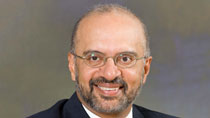
The CEO of DBS says it’s not enough to apply digital “lipstick.”
DBS is one of the leading financial-services groups in Asia. Headquartered and listed in Singapore, the company has a growing presence across the region and aspires to be what it calls “the Asian Bank of choice for the new Asia.” One of the most important prongs of that ambition is the bank’s digital strategy—notably its determination to embrace technology, reimagine the customer journey, and make the bank’s culture more entrepreneurial. McKinsey senior partner Joydeep Sengupta recently sat down with Piyush Gupta, the CEO of DBS since 2009, to discuss the challenges and opportunities Gupta has encountered along the way and the future shape of banking, including the threat from platform companies.
We invested initially in two small, central teams of 12 to 15 people, which over time I merged. One of the teams was focused on customer experience, the second on innovation. In both cases, the objective was to catalyze a sense of how to innovate—what had to be done about customer journeys in the way of training, exciting people, getting this on the agenda. In hindsight, this focus on customer experience and innovation turned out to be good. When you give people the freedom to go and try a few things with a rubric that says, “As long as it helps the customer, it is worth doing,” it opens people’s minds and it opens up a lot of possibilities.
The Quarterly: How did you get your board and senior management aligned around the new approach?
Piyush Gupta: That’s a really important question, as most CEOs have to find a balance between short-term results and investing in the long term, which may mean compromising short-term financials. In our case, the board got behind this agenda very swiftly, in part because in 2012 we had an inorganic opportunity that failed. The board concluded that inorganic acquisitions would be very hard to come by. In 2014, after the board had signed off on the planning process, it gave us an incremental $200 million, in their words, “to go blow it up.” They said that if you can blow it up, then we might be able to make something worthwhile for the future.
 ブログ
ブログ